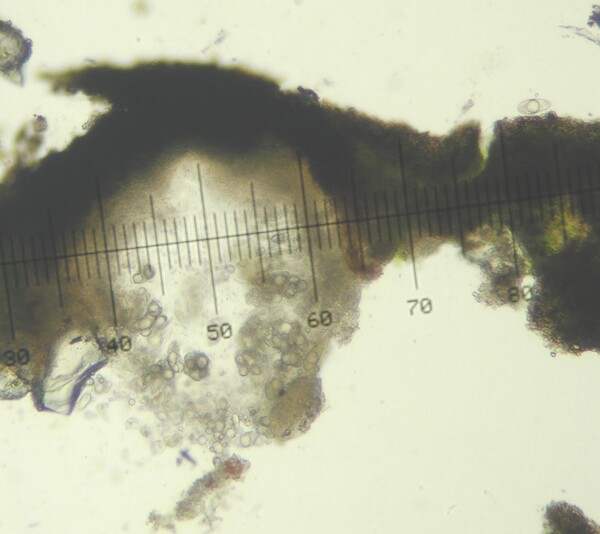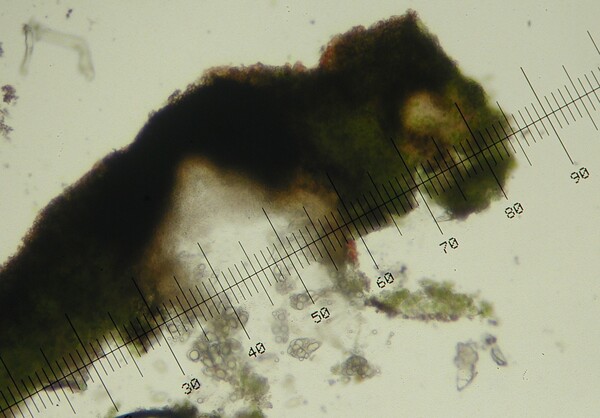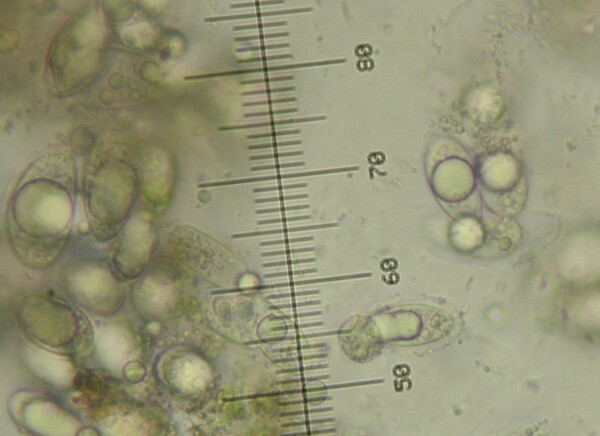Verrucaria latebrosa Körb.
Syst. Lich. Germ.: 349, 1855.
Synonyms: Verrucaria delita Nyl.; Verrucaria griseocinerascens (Vain.) Zschacke
Description: Thallus crustose, episubstratic, not subgelatinous when wet, 60-85 μm thick, grey-green, dark brown to pale grey-brown both when dry and when wet, continuous or cracked-areolate, smooth, matt to slightly shiny, delimited by a pale prothallus. Cortex poorly developed, with a brown pigment; algal layer 60-100 μm thick; medulla para- to prosoplectenchymatous, without a dark basal layer. Perithecia 1(-2) per areole, covered by a thalline layer except in the black apical part, forming low to moderate, 0.25-0.5 mm wide projections; involucrellum thick, limited to the apex of the exciple or spreading in upper half, rarely reaching to base-level in damaged specimens; exciple 0.195-0.3(-0.39) mm across, the wall colourless or almost so in lower part; hamathecium of up to 25 μm long periphyses and periphysoids, interascal filaments absents; hymenial gel hemiamyloid, I+ red (I+ blue at very low concentrations of I), K/I+ blue. Asci 8-spored, clavate, I-, fissitunicate, the wall thickened above, with an ocular chamber, dehiscent by extrusion of an endotunica to form a delicate rostrum, Verrucaria-type. Ascospores 1-celled, hyaline, ellipsoid, (18-)27-30(-37) x 8.5-12.5(-14.8) μm, surrounded by a gelatinous perispore (fresh material!). Photobiont chlorococcoid, the cells not arranged in vertical columns. Spot tests: K-, C-, KC-, P-, UV-. Chemistry: without lichen substances.
Growth form: Crustose
Substrata: rocks
Photobiont: green algae other than Trentepohlia
Reproductive strategy: mainly sexual
Periodically submerged (e.g. in creeks)
Commonnes-rarity: (info)
Alpine belt: very rare
Subalpine belt: rare
Montane belt: very rare
Dry submediterranean belt: absent
Humid submediterranean belt: absent
Padanian area: absent
pH of the substrata:
1 2 3 4 5
Solar irradiation:
1 2 3 4 5
Aridity:
1 2 3 4 5
Eutrophication:
1 2 3 4 5
Poleotolerance:
0 1 2 3
Altitudinal distribution:
1 2 3 4 5 6
Rarity
absent
extremely rare
very rare
rare
rather rare
rather common
common
very common
extremely common
Loading data...
Occurrence data
Predictive map
Growth form: Crustose
Substrata: rocks
Photobiont: green algae other than Trentepohlia
Reproductive strategy: mainly sexual
Periodically submerged (e.g. in creeks)
Commonnes-rarity: (info)
Alpine belt: very rare
Subalpine belt: rare
Montane belt: very rare
Dry submediterranean belt: absent
Humid submediterranean belt: absent
Padanian area: absent
pH of the substrata:
| 1 | 2 | 3 | 4 | 5 |
Solar irradiation:
| 1 | 2 | 3 | 4 | 5 |
Aridity:
| 1 | 2 | 3 | 4 | 5 |
Eutrophication:
| 1 | 2 | 3 | 4 | 5 |
Poleotolerance:
| 0 | 1 | 2 | 3 |
Altitudinal distribution:
| 1 | 2 | 3 | 4 | 5 | 6 |
Rarity
absent
extremely rare
very rare
rare
rather rare
rather common
common
very common
extremely common
Loading data...
Occurrence data
Predictive map









